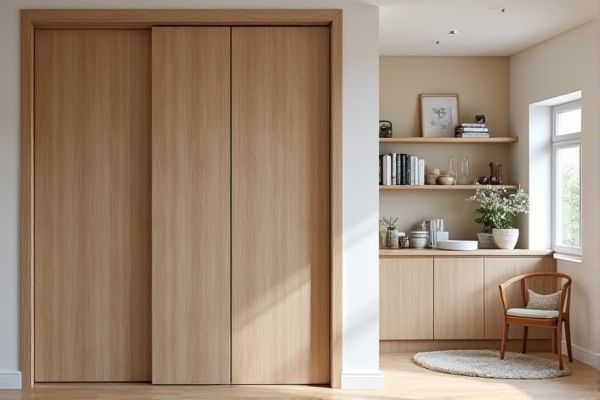
Swing-door cabinets offer easy access with a single door that opens outward, ideal for spaces needing full visibility and quick reach, while bifold cabinets save space by folding doors inward, perfect for tight areas where door clearance is limited. Discover the advantages and best uses of each cabinet type to determine which fits your Your needs by reading the full article.
Table of Comparison
| Feature | Swing-Door Cabinet | Bifold Cabinet |
|---|---|---|
| Door Mechanism | Single panel door swings outward on hinges | Two or more panels fold together on hinges |
| Space Efficiency | Requires clearance space to open fully | Consumes less space when opened |
| Installation Complexity | Simple and straightforward | More complex due to multiple panels and tracks |
| Accessibility | Full access to cabinet interior when open | Partial access; may limit use of interior corners |
| Durability | Fewer moving parts, generally durable | More moving parts, potential for wear and maintenance |
| Cost | Typically lower cost | Usually higher cost due to complexity |
| Ideal Use | Rooms with ample clearance space | Spaces with limited room for door swing |
Introduction: Understanding Swing-Door and Bifold Cabinets
Swing-door cabinets feature single-panel doors that pivot on hinges, providing full access to the cabinet interior with a simple outward swing. Bifold cabinets use doors divided into two sections connected by hinges that fold inward, optimizing space in tight areas by minimizing door clearance. Both styles offer distinct advantages for kitchen or storage solutions, influencing accessibility, spatial efficiency, and aesthetic appeal.
Design Overview: Swing-Door Cabinets
Swing-door cabinets feature a single, solid door that opens outward on hinges, providing full access to the cabinet interior. Their design offers a sleek and traditional appearance, ideal for classic or modern kitchen layouts where space allows the door to swing freely. You benefit from easy access and full visibility of contents, unlike bifold cabinets that split the door into two folding panels to save space.
Design Overview: Bifold Cabinets
Bifold cabinets feature two narrower door panels connected by hinges, allowing the doors to fold and stack neatly to the side, maximizing accessibility in tight spaces. Their compact folding mechanism enables wider openings without requiring additional clearance compared to swing-door cabinets, making them ideal for small kitchens or closets. The streamlined design supports modern aesthetics while enhancing functional efficiency in confined environments.
Space Efficiency: Which Cabinet Saves More Room?
Swing-door cabinets require clear space in front to open fully, which can limit room efficiency in tight areas. Bifold cabinets fold inward, reducing the door's footprint and making them ideal for compact spaces where maximizing square footage is crucial. Your choice depends on available clearance and how much floor space you need to conserve.
Accessibility and Ease of Use
Swing-door cabinets provide full access to the interior space with a single door that opens completely, allowing you to easily reach items without obstruction. Bifold cabinets, consisting of hinged panels that fold, offer space-saving advantages but may restrict access to internal contents due to their partial opening mechanism. For ease of use and maximum accessibility, swing-door cabinets are often preferred in kitchens or storage areas where quick and unobstructed reach is important.
Aesthetic Appeal and Style Choices
Swing-door cabinets offer a classic aesthetic with clean, uninterrupted surfaces that suit traditional and contemporary interiors, while bifold cabinets provide a modern, space-saving design ideal for compact areas and dynamic layouts. Your choice will impact the visual flow and style consistency of your space, as swing doors create a solid, polished look, whereas bifold doors introduce texture and movement with their segmented panels. Both styles come in diverse finishes and materials, allowing customization to match your decor preferences and enhance your room's overall appeal.
Installation and Maintenance Considerations
Swing-door cabinets require straightforward installation with hinges mounted on the cabinet frame, making them easier to align and replace if necessary. Bifold cabinets involve more complex hardware, including pivot brackets and tracks, which demand precise adjustments for smooth operation and may require periodic tightening or lubrication. Your choice affects long-term maintenance needs, with swing doors generally offering simpler upkeep compared to the intricate mechanisms of bifold systems.
Durability and Longevity Comparison
Swing-door cabinets often offer greater durability due to their robust hinge mechanisms and solid door construction, making them ideal for heavy, frequent use in kitchens. Bifold cabinets, while space-efficient, typically feature more complex hardware that can be prone to wear and require more maintenance over time. Your choice should consider how much daily stress the cabinet doors will endure to ensure longevity and sustained performance.
Cost Differences: Swing-Door vs Bifold Cabinets
Swing-door cabinets generally cost less than bifold cabinets due to simpler hardware and construction, making them a budget-friendly choice for various spaces. Bifold cabinets require specialized hinges and more precise installation, increasing both material and labor expenses. Your decision may hinge on balancing upfront costs with functional and aesthetic preferences in your cabinetry design.
Choosing the Best Cabinet for Your Space
Swing-door cabinets offer full access and a classic look ideal for larger spaces where you can easily open doors without obstruction. Bifold cabinets save space by folding inward, making them perfect for narrow or compact areas where maximizing every inch is crucial. Your choice depends on the room layout and how much clearance you have for door swing.
 homyna.com
homyna.com